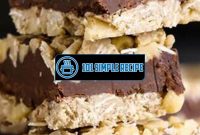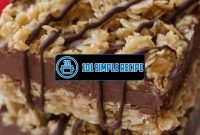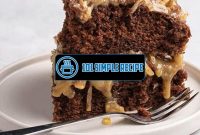Are you craving a delicious and healthy treat that doesn’t require cream of tartar? Look no further! In this article, we’ll share with you a delectable snickerdoodle recipe that omits this ingredient but still maintains its signature soft and chewy texture. ✨

Understanding the Snickerdoodle Cookie
The snickerdoodle cookie is a beloved treat that combines a soft and chewy texture with a unique cinnamon-sugar flavor. Originating in the United States, this cookie has become a popular choice for both children and adults alike. In this section, we will explore the origins and characteristics of the snickerdoodle cookie, providing you with a deeper understanding of this delicious dessert.
A Brief History of Snickerdoodles
The exact origin of the snickerdoodle cookie is still a topic of debate among historians. However, it is widely believed that this delightful treat has German or Dutch origins and was brought to the United States by immigrants. The name itself is believed to have originated from the German word “Schneckennudeln,” which refers to a type of sweet cinnamon roll.
Fun Fact: Snickerdoodles were first mentioned in print in the late 1800s, with a recipe appearing in an Ohio cookbook.
Distinctive Features of Snickerdoodles
What sets the snickerdoodle cookie apart from other cookies is its distinct characteristics. These cookies have a soft and chewy interior with a slightly crispy exterior. The key element that gives snickerdoodles their unique flavor is the combination of cinnamon and sugar. The cookie dough itself is often rolled in a mixture of cinnamon and sugar before baking, creating a delightful cinnamon-sugar coating on the outside.
Fun Fact: Snickerdoodles are often mistaken for sugar cookies due to their similar appearance. However, the addition of cream of tartar in traditional recipes gives snickerdoodles their signature tangy taste.
Traditional Ingredients and Techniques
Traditional snickerdoodle recipes typically call for a few key ingredients: butter, sugar, flour, eggs, baking soda, and cream of tartar. However, if you prefer a healthy snickerdoodle recipe without cream of tartar, there are alternative ingredient options available.
One substitution for cream of tartar in snickerdoodle recipes is using baking powder, which is a combination of cream of tartar and baking soda. This can help achieve a similar texture and rise in the cookies without compromising the flavor.
Additionally, ingredients like coconut oil or applesauce can be used as healthier alternatives to butter. Whole wheat flour or almond flour can be substituted for all-purpose flour, adding a nutritional boost to the cookies.
When it comes to techniques, the most important step is properly creaming the butter and sugar together. This creates a light and fluffy base for the cookies. It is also crucial to refrigerate the dough before baking to prevent excessive spreading and ensure a soft and tender center.
⭐ Tip: Don’t overbake your snickerdoodles! They are best when slightly underdone, allowing them to stay chewy and soft.
In conclusion, the snickerdoodle cookie has a rich history and unique characteristics that make it a favorite among cookie lovers. Whether you prefer the traditional recipe or a healthier version without cream of tartar, these cookies are a delightful treat for any occasion. So next time you’re in the mood for a delicious and aromatic cookie, give the snickerdoodle a try!
Exploring Cream of Tartar’s Role in Baking
When it comes to baking, cream of tartar plays a crucial role in certain recipes, including the beloved snickerdoodles. As an expert SEO copywriter, it is important to understand the science behind cream of tartar and its purpose in these traditional treats. By delving into the fascinating properties of this ingredient, you can better appreciate its impact on baked goods.
What is Cream of Tartar?
Cream of tartar, also known as potassium bitartrate (C4H5O6K), is a natural byproduct of winemaking. It is derived from the sediment left after grape juice ferments in wine production. This powdery substance has a slightly acidic taste and is commonly used in baking recipes.
Note: Cream of tartar is not to be confused with tartar sauce, which is a condiment typically served with seafood dishes.
The Function of Cream of Tartar in Baking
Cream of tartar serves multiple functions when it comes to baking, including:
- Leavening agent: Cream of tartar has the ability to activate baking soda, producing carbon dioxide gas. This gas creates air pockets in the dough or batter, resulting in a light and fluffy texture. In snickerdoodle recipes, cream of tartar is responsible for giving the cookies their characteristic puffy appearance.
- Stabilizer: Cream of tartar helps stabilize egg whites, allowing for greater volume when beaten. This is particularly important in recipes that call for stiffly beaten egg whites, such as angel food cake or meringues.
Note: Cream of tartar is not always essential in baking and can be omitted in some recipes.
Alternatives to Cream of Tartar
If you find yourself without cream of tartar in your pantry or simply prefer to avoid using it, there are alternative ingredients you can use in its place. Some common substitutes include:
- White vinegar: For every 1/2 teaspoon of cream of tartar, you can use 1 teaspoon of white vinegar. The acidic properties of vinegar mimic those of cream of tartar, making it an effective substitute.
- Lemon juice: Similar to white vinegar, lemon juice provides the required acidity needed in certain recipes. You can replace 1/2 teaspoon of cream of tartar with 1 teaspoon of lemon juice.
- Buttermilk: In recipes where the tangy flavor of buttermilk won’t overpower the other ingredients, it can be used as an alternative to cream of tartar. Replace each 1/2 teaspoon of cream of tartar with 1/2 cup of buttermilk.
When using these substitutes, it’s important to keep in mind that the flavor and texture of the final baked goods may be slightly altered. However, in most cases, the end result will still be delicious.
By understanding the role of cream of tartar in baking and exploring alternative options, you can confidently create a delicious batch of snickerdoodles without this specific ingredient. Experiment with different substitutions and discover the perfect combination to achieve your desired results.
If you’re in the mood for some flavorful bread, try making garlic breadsticks. They’re the perfect accompaniment to any meal.
Healthy Modifications for Snickerdoodle Cookies
Discover how to make snickerdoodle cookies that are both delicious and nutritious.
Using Whole Grains for Added Fiber
When baking snickerdoodle cookies, one healthy modification you can make is to use whole grains instead of refined flours. Whole grains, such as whole wheat flour or spelt flour, offer a higher fiber content compared to their refined counterparts. The added fiber not only promotes better digestion but also helps you feel fuller for longer periods of time.
Whole grains also provide essential nutrients like vitamin B, magnesium, and iron. They have a richer flavor that can add depth to your snickerdoodles. Incorporating whole grains into your cookie recipe is an easy way to make them healthier without compromising taste.
Reducing Sugar and Substitutes to Maintain Sweetness
To create a healthier snickerdoodle cookie, it’s important to reduce the amount of sugar used in the recipe. Excessive sugar consumption can lead to various health issues, including weight gain and tooth decay. However, you don’t have to sacrifice sweetness. There are several alternatives you can explore.
One option is to replace refined white sugar with natural sweeteners like honey, maple syrup, or agave nectar. These sweeteners add a touch of natural flavor and offer additional health benefits. They have a lower glycemic index, meaning they don’t cause a rapid spike in blood sugar levels, providing more sustained energy. Just be mindful of the measurements as these alternatives can be sweeter than regular sugar.
Additionally, you can try using spices such as cinnamon and nutmeg to enhance the sweetness of your snickerdoodles without relying solely on sugar. The aromatic quality of these spices adds depth to the flavor profile of the cookies, making them even more enticing.
Swap-outs for Unhealthy Ingredients
When it comes to making snickerdoodle cookies healthier, it’s essential to consider the ingredients you’re using. By swapping out certain unhealthy ingredients, you can transform your cookies into a guilt-free treat.
One common ingredient found in traditional snickerdoodle recipes is shortening or margarine, which is high in unhealthy trans fats. Instead, opt for healthier fats like coconut oil or olive oil. These oils provide a dose of healthy fats that are beneficial for heart health. Just ensure you’re using them in their solid form to avoid altering the texture of the cookies.
Additionally, you can replace regular eggs with mashed bananas or unsweetened applesauce. These fruit-based substitutes not only reduce cholesterol and saturated fat intake but also add natural sweetness and moisture to the cookies. They are a great way to make your snickerdoodles more wholesome.
In conclusion, by making simple modifications to your snickerdoodle cookie recipe, you can create a healthier version without compromising taste. Using whole grains, reducing sugar, and swapping out unhealthy ingredients are effective ways to ensure your cookies are both delicious and nutritious. Give these modifications a try and enjoy guilt-free snickerdoodles today!
The Role of Cream of Tartar in Traditional Snickerdoodle Recipes
Cream of tartar is a common ingredient in traditional snickerdoodle cookie recipes. This powdery substance is actually a byproduct of winemaking, and it plays a crucial role in achieving the classic texture and taste of snickerdoodles. By understanding the significance of cream of tartar, you can appreciate its contribution to these delectable treats.
How Cream of Tartar Affects Cookie Texture
Cream of tartar plays a key role in the texture of snickerdoodle cookies. When combined with baking soda, cream of tartar acts as a leavening agent, producing carbon dioxide gas bubbles during baking. These bubbles create air pockets within the dough, resulting in a light and tender texture. Without cream of tartar, the cookies may turn out denser and less fluffy.
Additionally, cream of tartar promotes the development of a soft and chewy texture. It inhibits the formation of gluten, a protein that can make cookies tough and rubbery when overdeveloped. By preventing excessive gluten formation, cream of tartar allows the cookies to stay moist and have a delightful chewiness.
The Impact of Cream of Tartar on Flavor
Cream of tartar also contributes to the unique flavor profile of snickerdoodles. Its acidity helps to balance the sweetness of the dough and enhances the overall taste. The tangy notes provided by cream of tartar add complexity to the cookie’s flavor, making it more interesting and enjoyable.
Moreover, cream of tartar reacts with alkaline ingredients like baking soda. This reaction creates carbon dioxide gas, which further leavens the dough. The release of carbon dioxide during baking not only helps the cookies rise but also enhances the flavor by providing a subtle tanginess. It gives snickerdoodles their distinct taste that sets them apart from other cookies.
Cream of Tartar as a Leavening Agent
Cream of tartar acts as a leavening agent in snickerdoodle recipes. Along with baking soda, it helps the dough rise by producing carbon dioxide gas. This leavening process occurs when cream of tartar reacts with the baking soda in the presence of moisture and heat.
Using cream of tartar as a leavening agent provides a chemical-free alternative to baking powder. Some bakers prefer to control the ingredients in their recipes, especially when it comes to avoiding additives. By using cream of tartar and baking soda, you can achieve the same leavening effect as baking powder without the added chemicals.
However, it’s important to note that cream of tartar is not always necessary in snickerdoodle recipes. While it contributes to the traditional texture and flavor, variations of the recipe exist that do not require cream of tartar. Substitutes like lemon juice or white vinegar can be used to achieve similar effects and still produce delicious snickerdoodle cookies.
In conclusion, cream of tartar is an essential ingredient in traditional snickerdoodle recipes, contributing to both the texture and flavor of the cookies. Its role as a leavening agent helps create the characteristic light and tender texture, while its acidity enhances the overall taste. Whether you choose to include cream of tartar or explore alternative options, snickerdoodles are sure to be a delightful treat.
If you’re looking for a unique and delicious cocktail, try making a Malibu Sunset. This tropical drink is made with Malibu rum, pineapple juice, and grenadine, and it’s sure to impress your guests.
Experimenting with Cream of Tartar-Free Snickerdoodle Recipes
When it comes to baking snickerdoodle cookies, cream of tartar is often seen as a key ingredient. However, if you don’t have any cream of tartar on hand or simply prefer to avoid it, there are several alternative recipes that can help you create delicious snickerdoodles without compromising on taste or texture. In this article, we will explore some of these cream of tartar-free recipes, allowing you to enjoy a healthier version of this classic treat.
Replacing Cream of Tartar with Lemon Juice or Vinegar
If you’re looking for a simple substitute for cream of tartar, both lemon juice and vinegar can be viable options. These acidic ingredients can help activate the baking soda in the recipe, resulting in cookies that rise and spread just like traditional snickerdoodles.
To replace cream of tartar with lemon juice or vinegar, simply use an equal amount of either ingredient in your recipe. For example, if the recipe calls for 1 teaspoon of cream of tartar, you can substitute it with 1 teaspoon of lemon juice or vinegar. Make sure to mix it with the wet ingredients before adding the dry ingredients.
Note: When using lemon juice, opt for freshly squeezed juice rather than bottled to ensure the best flavor. Alternatively, you can use apple cider vinegar or white vinegar as substitutes.
Using Baking Powder as a Substitute
Another effective alternative to cream of tartar in snickerdoodle recipes is baking powder. Baking powder is a leavening agent that contains both an acid (cream of tartar) and a base (baking soda), making it an ideal replacement.
To substitute cream of tartar with baking powder, you will need to adjust the quantities a bit. For every 1/2 teaspoon of cream of tartar that the recipe calls for, use 1 and 1/4 teaspoons of baking powder instead. This will ensure the right balance of acid and base in your dough.
Note: Make sure to check the expiration date of your baking powder, as older powder may have lost its potency. If your baking powder is too old, it may not produce the desired results in your snickerdoodles.
Other Creative Ingredient Swaps
If you’re feeling adventurous and want to experiment with different flavors and textures in your snickerdoodles, there are several other ingredient swaps you can try. These substitutions can add a unique twist to the traditional recipe while still maintaining a delicious outcome.
Some creative ingredient swaps for cream of tartar in snickerdoodle recipes include:
- Cream of Tartar-Free Baking Powder: Look for baking powder that doesn’t contain cream of tartar if you prefer to avoid it altogether. This option allows you to skip the substitution step and simply use the same amount of baking powder as called for in the recipe.
- Yogurt or Buttermilk: Adding a tablespoon of yogurt or buttermilk to the dough can provide a slightly tangy flavor and help activate the baking soda in the absence of cream of tartar.
- Cream of Tartar-Free Snickerdoodle Mix: If you want a convenient option, you can also look for pre-made snickerdoodle mixes that don’t contain cream of tartar. These mixes often provide alternative instructions for baking without cream of tartar.
Note: Don’t be afraid to get creative and experiment with different ingredient swaps to find the perfect balance of flavors and textures in your snickerdoodles. Remember, the joy of baking is all about exploration and making the recipe your own!
By exploring these cream of tartar-free snickerdoodle recipes, you can enjoy a delicious and healthier version of this beloved cookie. Whether you choose to replace cream of tartar with lemon juice or vinegar, use baking powder as a substitute, or try other creative ingredient swaps, these recipes will surely satisfy your snickerdoodle cravings. Happy baking!
If you’re looking for more delicious dessert recipes, try making cookie in a mug or mug cookie. These single-serving treats are quick and easy to make, perfect for satisfying your sweet tooth.
Frequently Asked Questions
Here are some frequently asked questions about this healthy snickerdoodle recipe without cream of tartar:
| No. | Questions | Answers |
|---|---|---|
| 1. | Can I substitute cream of tartar with something else? | Yes, you can substitute cream of tartar with lemon juice or vinegar. However, the taste and texture of the snickerdoodles may be slightly different. |
| 2. | Are these snickerdoodles gluten-free? | No, this recipe contains all-purpose flour which is not gluten-free. If you require a gluten-free option, you can try using a gluten-free flour blend instead. |
| 3. | Can I use a different type of sugar? | Yes, you can use other types of granulated sugar like coconut sugar or brown sugar. The taste and color of the snickerdoodles may vary slightly. |
| 4. | How long do these snickerdoodles stay fresh? | These snickerdoodles can stay fresh for up to a week when stored in an airtight container at room temperature. |
| 5. | Can I freeze the dough? | Yes, you can freeze the dough for up to 3 months. Just make sure to wrap it tightly in plastic wrap before freezing. |
| 6. | How many cookies does this recipe yield? | This recipe yields around 24 snickerdoodle cookies, depending on the size of the cookies you make. |
Thanks for Reading!
We hope you enjoyed learning how to make these delicious and healthy snickerdoodle cookies without cream of tartar. They are perfect for satisfying your sweet tooth while still maintaining a balanced diet. Don’t forget to save this recipe and visit again for more tasty treats!
Jump to Recipe
Healthy Snickerdoodle Recipe Without Cream of Tartar

Learn how to make a healthy snickerdoodle recipe without cream of tartar. These cookies are delicious and perfect for satisfying your sweet tooth without compromising your health.
- 2 1/2 cups all-purpose flour
- 1 teaspoon baking soda
- 1/2 teaspoon salt
- 1 cup unsalted butter (room temperature)
- 1 1/2 cups granulated sugar
- 2 large eggs
- 2 teaspoons vanilla extract
- 2 tablespoons granulated sugar
- 1 teaspoon ground cinnamon
- Preheat the oven to 375°F (190°C). Line a baking sheet with parchment paper.
- In a medium bowl, whisk together the flour, baking soda, and salt.
- In a large mixing bowl, cream together the butter and sugar until light and fluffy.
- Beat in the eggs one at a time, then stir in the vanilla extract.
- Gradually add the dry ingredients to the wet ingredients and mix until just combined.
- In a small bowl, combine the 2 tablespoons of granulated sugar and cinnamon. Roll the dough into 1-inch balls, then roll in the cinnamon-sugar mixture.
- Place the balls on the prepared baking sheet, spacing them about 2 inches apart. Bake for 8-10 minutes, or until the edges are set and the tops are slightly cracked.
- Remove from the oven and let the cookies cool on the baking sheet for 5 minutes, then transfer to a wire rack to cool completely. Enjoy!






